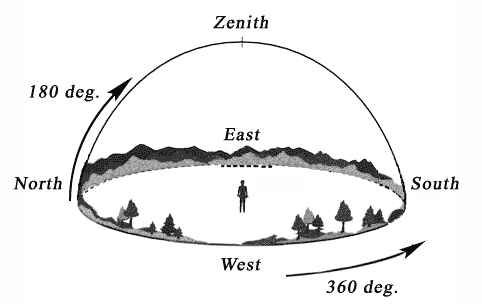Suppose we want to find and measure the angular size of an extended object like a galaxy. The angular size of a patch of sky where we look can be very important. If we use a telescope to examine an area of large angular size, like 20 x 20 degrees, the galaxy may almost disappear, like a needle in a haystack. A whole galaxy can look like just another star. In fact galaxies weren't discovered until well after the invention of the telescope for this reason. If we get a better telescope (increase the magnification), we are examining a smaller patch of sky in greater detail. This is fine as long as the area still includes the galaxy. Then the galaxy occupies more of the image. It's the same when you zoom in on a friend with a camera lens; the photograph is the same size, but you get a "close up." Can an image have too much magnification? Yes, because the size of the film limits the size of the picture: zoom in too much and you might see only your friend's nose! In astronomy too, the size of the telescope's field of view (lens), and the light detecting device (film) attached to it, are limited. In this exercise, we will vary the angular size and magnification
of an image, keeping the physical size of the image the same. This is like
the photography example above, in which the photographer is able to
change the distance to his subject. This is not entirely
realistic, as our distance from most large objects like Andromeda does not
change. The image producing engine we will use is able to
simulate this effect by manipulating the pixels of large images. As a general rule, the larger the angular area of
sky that is visible in your image, the lower the magnification. The higher the
magnification, the smaller the area of sky shown in the image. Your goal
is to determine the best magnification for measuring the angular size of the
object Andromeda, and to estimate its angular size.
Procedure:
Read all instructions through #5 before you begin.
- Go to the Skyview site: http://skyview.gsfc.nasa.gov/easy.html.
Skyview is an interface to an archive that supplies images of many astronomical objects at various
wavelength and
magnifications.
- Enter the name "Andromeda" into the space labeled "Coordinates of Source,"
The librarian recognizes common names for many objects, so you don't need numerical coordinates.
- In the table labeled "Survey[s]" check optical, for a visible
light image.
- Go down to the "Optional Parameters" and use the pull-down menu
(click and hold) to change the "Image Size" to 0.1x 0.1 degrees.
- Scroll back up to "Initiate Request" and click on the
"submit" button.
|
